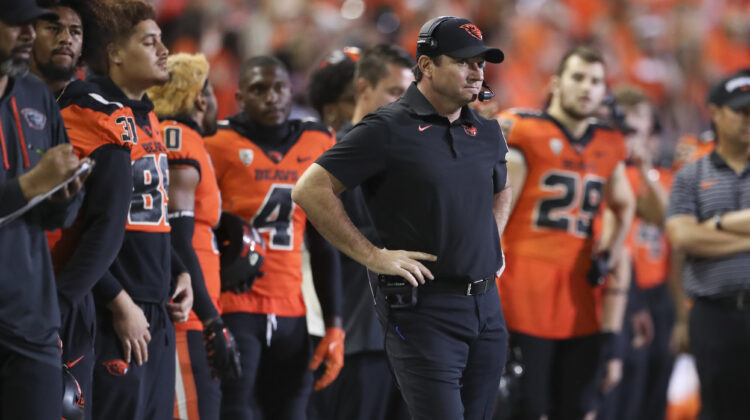Do Oregon State and Washington State need the Pac-12 to stay intact for them to retain the assets? Otherwise, it would be split between all teams? — @CamKode
We have a lot to address with the Beavers and Cougars, and this is a great place to start.
First, let’s assume the ACC offers membership to Stanford and Cal next week. (We attach a 70 percent probability to that outcome. Momentum is trending in favor of the schools following their financial concessions.)
At that point, the Beavers and Cougars would be the only remaining members of the Pac-12 as of next summer.
Best we can tell, they would have three options:
— Join the Mountain West in a standard realignment move.
— Join the American Athletic Conference in a standard realignment move.
— Rebuild the Pac-12 with teams from the Mountain West.
The third option might be the most lucrative, and we’ll dive into that aspect momentarily. The front-and-center issue is determining control of the Pac-12’s assets.
For this, we went straight to the conference bylaws. Chapter 1, Section 4 addresses “Dissolution.”
It states, in part:
“In the event of the dissolution or final liquidation of the Conference, all of the remaining assets and property of the Conference shall, after paying or making provision for the payment of all of the liabilities and obligations of the Conference and for necessary expenses thereof, be distributed to the members of the Conference …”
Final determination would be made by the attorneys, of course. But we read that section to mean if Washington State and Oregon State entered either the Mountain West or the American, the conference would be dissolved and the assets split among all 12 current members.
However, we also take the bylaws to suggest that if the conference remains a legal entity, the outbound schools would forfeit their claim to any assets and the remaining members would be entitled to … everything.
Section 3 addresses “Withdrawal”:
“ … if any member does deliver a notice of withdrawal prior to August 1, 2024, in violation of this chapter, the Conference shall be entitled to an injunction and other equitable relief to prevent such breach, and if a court of competent jurisdiction shall deny the Conference such injunctive relief, the Conference shall be entitled to retain all the media and sponsorship rights in the multi-player video distribution (MPVD) and telecommunications/wireless categories of the member purporting to withdraw through August 1, 2024, even if the member is then a member of another conference …”
It sure seems like Washington State and Oregon State would be entitled to all the assets if they remain in the conference and orchestrate a salvage operation.
If they join the Mountain West or American, they become just like the Pac-12’s other departing schools.
If they stay put, they own the assets.
What are the specifics on this Pac-12 “war chest” I’ve heard about? Could it fund Oregon State and Washington State as football Independents for a year or two until the next round of conference collapse? — @Charlie25708302
I’m not sure “war chest” is the right description; we simply don’t know enough about the assets and liabilities.
However, the Pac-12’s tax filings from the 2022 fiscal year show $43 million in net assets, and a portion of that total is considered emergency reserves. Exactly how much, we cannot say. But WSU and OSU would, in theory, control that pot of cash.
What’s more, the Pac-12 is expected to receive $65 million from NCAA Tournament units earned by the current 12 teams that will be paid out over the course of the decade, according to Hotline estimates.
The outbound schools don’t take the cash with them into their new leagues. It would stay with the Pac-12, with Washington State and Oregon State, if the conference remains a viable entity.
As for the Comcast overpayment scandal, we can only pass along what the Hotline has been told: The money is being withheld from revenue distributions to all 12 schools before the end of the current fiscal year.
In other words, it would not linger as a liability for WSU and OSU as the sole remaining members.
There could be value elsewhere (Pac-12 Networks infrastructure, bowl contracts, sponsorship deals, etc.), just as there could be liabilities hidden around various corners.
But the emergency reserve fund and the NCAA Tournament units should constitute a significant asset base from which the Cougars and Beavers can move forward.
Retired Fox Sports president Bob Thompson floated a “reverse merger” scenario between the Mountain West and the “Pac-2” that would allow the remaining schools to keep all the NCAA Tournament cash. A new Pac-12 could get a small media deal and emerge healthy. Thoughts? — @pfnnewmedia
Washington State and Oregon State cannot exist in a two-team conference, of course — they would need other members. And the “reverse merger” concept is much more than a “float.” It’s under serious discussion.
But the process would be massively complicated and require the Mountain West schools to vote to dissolve their league in order to move into the Pac-12.
(If the league isn’t dissolved, then any departing members seemingly would owe exit penalties to those left behind.)
And don’t forget about the media rights piece for the merged conference. Would Fox and CBS, which own the Mountain West’s broadcast rights until 2026, consent to switch their agreement to the reformed Pac-12? Or would the reformed conference seek a new partner? (Hello, Apple!)
There are loads of issues to sort through — the biggest winners in realignment, now and always, are billable hours — but the reverse merger makes sense because the Pac-12’s brand, although battered, would carry more long-haul value than the Mountain West brand.
In our view, it’s better for 12 schools to enter the former than for two schools to join the latter.
Realignment is nuts.
If the Mountain West and Pac-12 merge, how do schools like Hawaii, Nevada, San Jose State and Utah State protect themselves from being left behind? — @MarkCarbonaro2
Again, we lack legal expertise. But it seems the schools would have to receive protection within the wording of the transition documents to ensure they were not lost in the shuffle, so to speak.
It’s possible the bylaws of the merged league would need to be drafted and signed before the official dissolution of the Mountain West.
A reverse merger of this nature, unprecedented in the modern era, would take months to complete.
For us Cougars and Beavers, when does this cluster end? — @Jeffharris2012
The ACC is expected to make a decision on Cal and Stanford by the middle of next week, but WSU and OSU will require more time to resolve their futures.
A reconstituted Pac-12, with schools from the Mountain West — and perhaps the American — would unfold over the course of months, not weeks.
Even if WSU and OSU decide to join the Mountain West or American in a standard realignment move, the process will seep into the upcoming football season.
It’s difficult for us to envision an outcome in which everything is wrapped up by Labor Day weekend.
Of the two, the American or the Mountain West, which one is the better option for Washington State and Oregon State? — @MarcSheehan006
If remaining under the Pac-12 banner is not a viable option for whatever reason, the two schools likely would have the option to join either the Mountain West or American in a traditional realignment move.
The former fits better geographically, which means it works for the athletes, and there’s enough alignment to create solid rivalries.
The latter conference has a more lucrative media deal with ESPN (reportedly $7 million per school per year) than the Mountain West has with Fox and CBS ($4.5 million, approximately).
However, it’s also a longer commitment. The American is locked in with ESPN until 2032, while the MW contract expires in 2026.
The Hotline’s general view on the matter — and we felt this way with the Pac-12 media rights negotiations, as well — is that the rapid changes within the sports media industry (and college football itself) lend themselves to shorter media agreements.
Let’s assume Oregon State and Washington State are headed to the Mountain West. How feasible do you think it would be for them each year to fundraise what they would be losing from the reduced media revenue to support their sports, namely football? — Andrew Constantinescu
That depends on the commitment from their donor bases — it’s not just about contributing to the university’s coffers; it’s also about NIL collectives — and the willingness of the presidents (WSU’s Kirk Schulz and OSU’s Jayathi Murthy) to add necessary resources from central campus.
If the football budgets remain at levels comparable to a Pac-12 existence (e.g., recruiting budgets, salaries, staff size, facilities), the Beavers and Cougars would have a competitive advantage in the Mountain West.
And keep in mind: The conference champion would be in line for an automatic berth in the College Football Playoff. Once the expanded format takes hold next season, there will always be one slot reserved for a team outside the Power Four.
The heavyweight leagues will do whatever it takes to avoid a lawsuit, after all.
What is your prediction for the future? Will former Pac-12 schools struggle to compete in their new conferences due to travel and recruiting issues? Will there be an effort to reconstitute the Pac-12 by 2031? — @TerryTerry79
That’s a great topic, one we’ll address in depth at a later point. The second question is especially intriguing because it cuts to the most fundamental issue of all: The structure of major college football in the 2030s.
The conference framework in place for the 2024 season is not likely to hold through the next decade, not with so many external economic forces squeezing the schools’ finances.
No topic fascinates us more than the look of college football in the 2030s. It’s something the Hotline will examine frequently in the coming months and years.
And it impacts every school in every conference.
What are you going to be covering once the Pac-12 is fully dissolved? — @FredJacobsen6
The same thing we covered before “Pac-12” was added to the name of this operation:
We will report on the schools and the issues that matter to them, on the field and off and regardless of conference affiliation or the banner under which the Hotline operates.
Fun fact: No Pac-12 team has made the playoff since the transition from College Hotline to Pac-12 Hotline in the summer of 2017. Maybe it’s us.
Also, we have already secured the URL WilnerHotline.com, which conveniently matches my Twitter handle.
Related posts:

(AP Photo/Ralph Freso, File)
Wilner Hotline -24/7 Sports Brandon Huffman now a Weekly Recruiting Contributor
(AP Photo/Ralph Freso, File)
Hotline mailbag: An SEC feud, the Pac-12 villain vacancy, the FCG switch, schedule options and more Wilner Mailbag -DEFCON 1 realignment scenario, should Oregon, Washington, UCLA and USC leave the conference?
Wilner Mailbag -DEFCON 1 realignment scenario, should Oregon, Washington, UCLA and USC leave the conference? 
(AP Photo/Marcio Jose Sanchez)
Business of Sports – Updated Power Five revenue projections show Pac-12 deficit expanding as COVID hits, ACC Network grows and Big Ten, SEC rake in the cash
